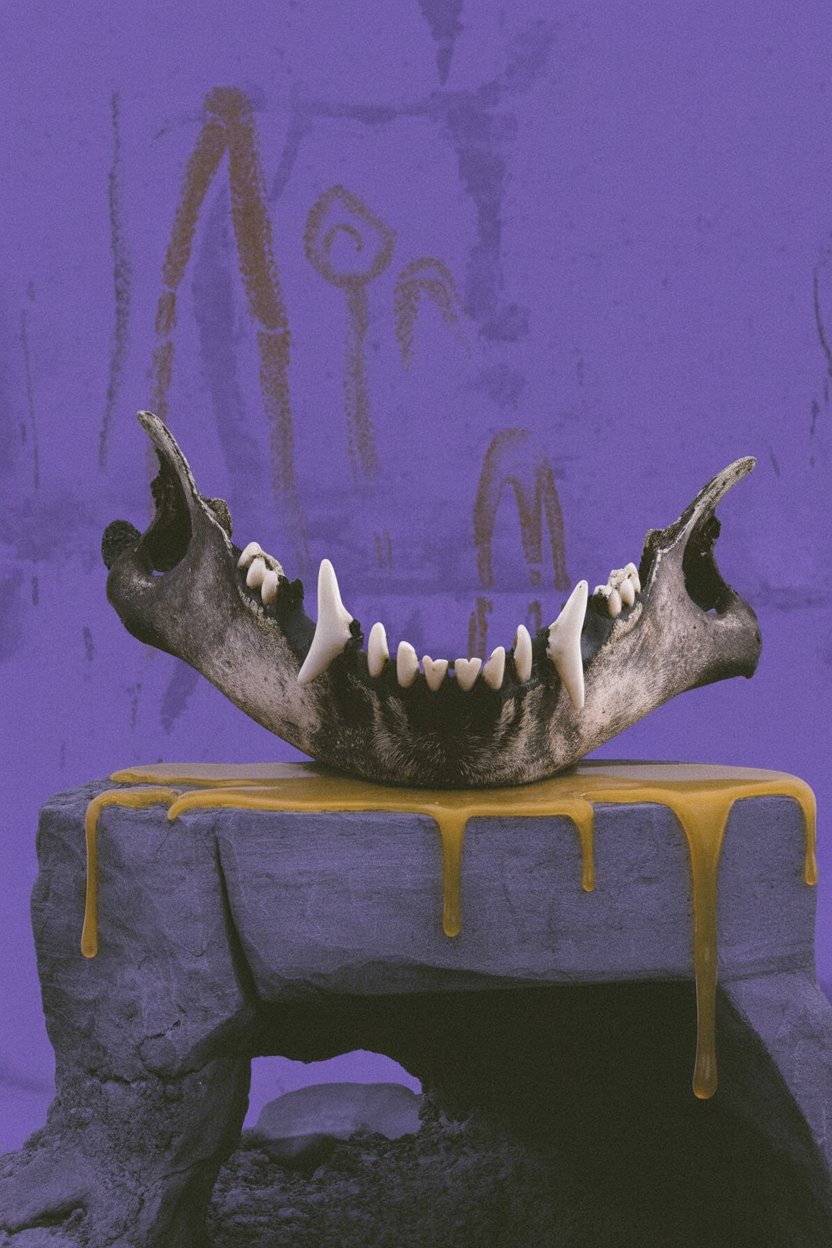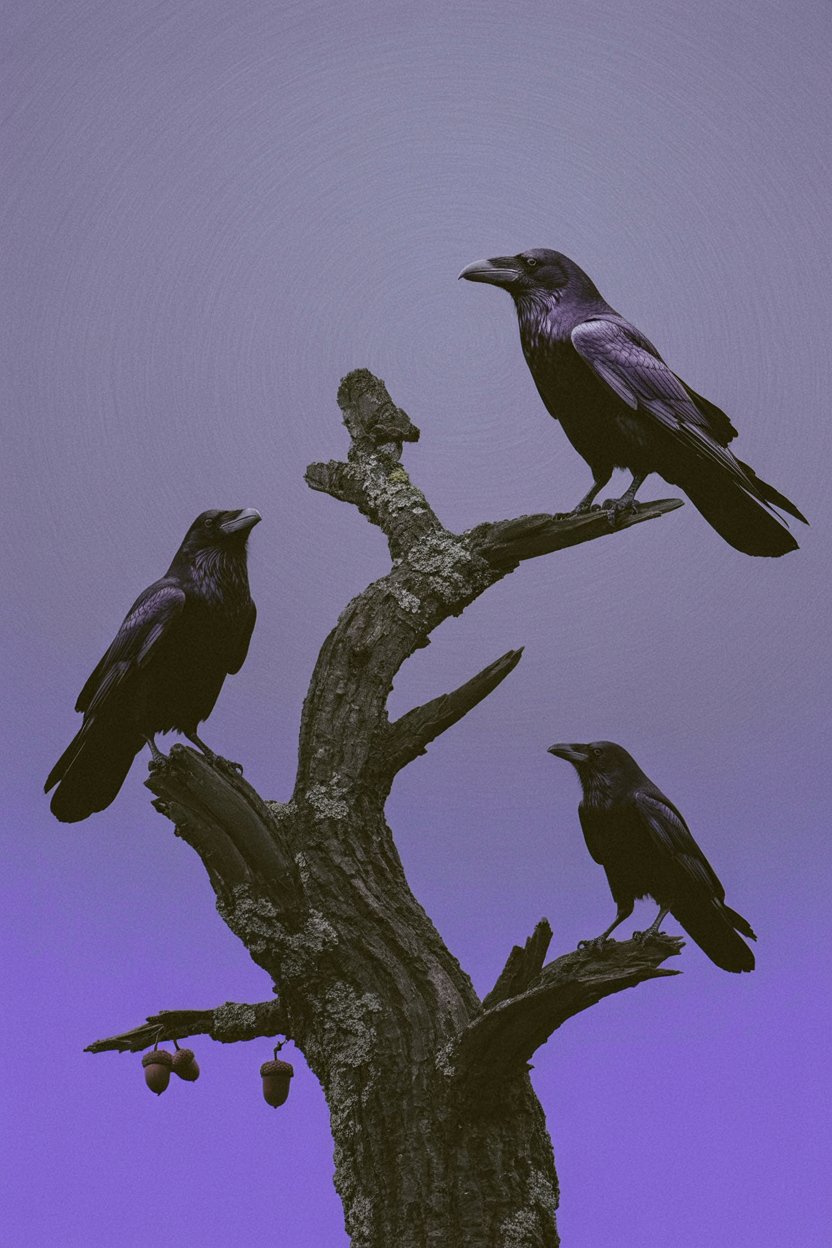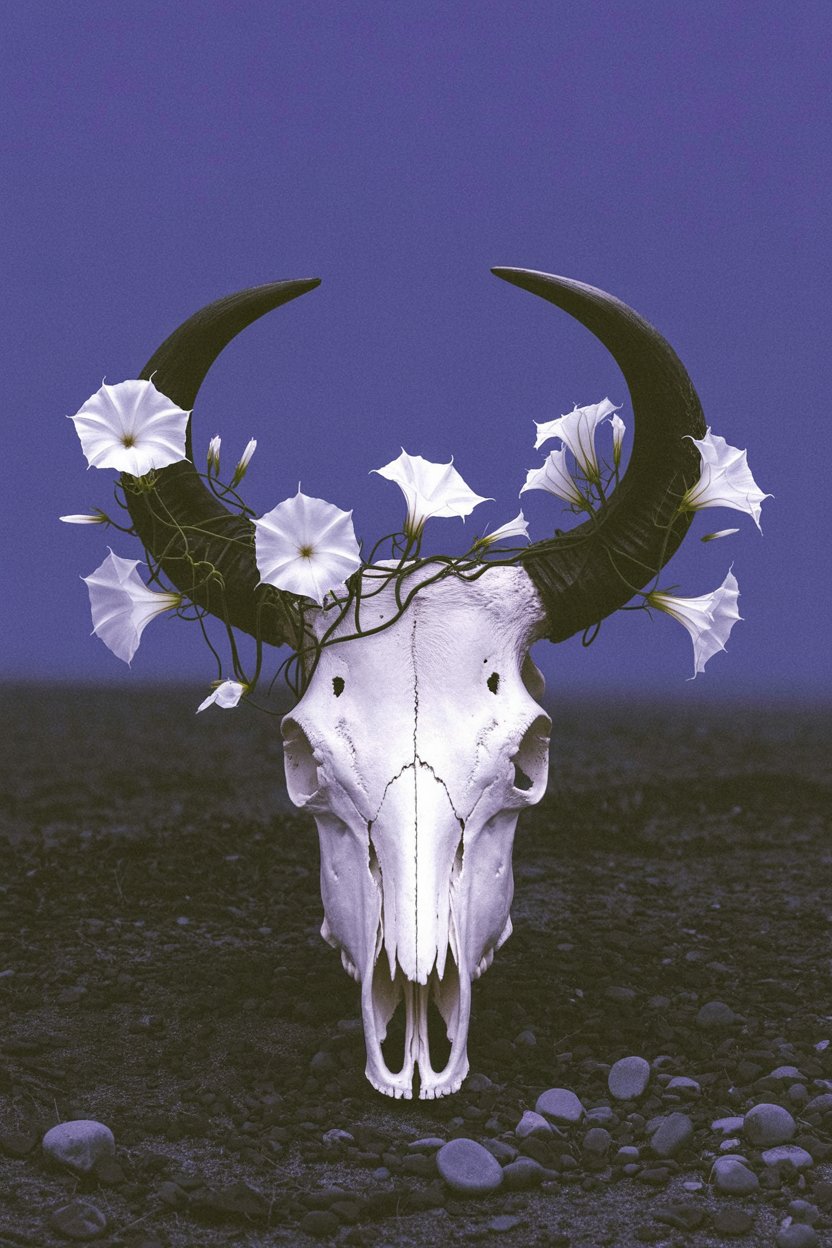Hekate’s Sacred Animals: Symbolic Meanings of Dogs, Crows, and Snakes
Please note that posts on this site may contain affiliate links
Hekate’s sacred animals are keys to understanding this ancient goddess of crossroads, witchcraft, and liminal spaces. Dogs serve as loyal psychopomps guiding souls between worlds, acting as threshold guardians who protect boundaries and warn of approaching death. Crows and ravens function as oracles and messengers, their intelligence and death associations making them perfect (though historically late) companions for divination and liminal work. Serpents embody transformation and chthonic wisdom, their skin-shedding cycles reflecting the death and renewal at the heart of Hekate’s mysteries.
Hekate’s menagerie extends far beyond this primary trio. Horses, black lambs, bulls, lions, wolves, and even red mullet fish appear in ancient sources connected to her worship. Each animal reveals different facets of her power, functioning as living symbols that encode her domains: the underworld, magic, crossroads, and the spaces between worlds.
Ancient peoples didn’t separate animals from divine nature the way we do. When Greeks depicted Hekate with dogs or described her as serpent-crowned, they recorded her actual companions, sacrifice offerings, manifestations, and messengers. Understanding them means understanding her.
Dogs: Loyal Psychopomps and Threshold Guardians
Dogs hold the strongest historical connection to Hekate. So strong, in fact, that her very name might mean “one who possesses dogs.” Ancient sources and modern practitioners document this deep bond.
The Etymology and Ancient Sources
A scholarly paper from the University of Copenhagen proposes that Hekate’s name derives from a Proto-Indo-European root meaning “she who has her own dogs.” While etymologists debate this interpretation, the sheer volume of dog associations in ancient sources makes it plausible. Dogs formed the core of Hekate’s identity. Ancient sources show this bond everywhere.
Ancient Greek pottery and statuary consistently show Hekate accompanied by dogs. In the Greek Magical Papyri, she’s invoked as “bitch” and “dog-faced.” These terms recognize her canine nature. The texts describe her appearing with dogs “larger than elephants, with shaggy black fur,” their ghostly barking announcing her presence.
The most famous dog myth involves Hecuba, queen of Troy. After witnessing her city’s fall and her children’s deaths, Hecuba’s grief transformed her. According to multiple ancient sources, she leapt into the sea, and Hekate took pity on her. The goddess transformed the queen into a black female dog, who then joined Hekate’s retinue as a devoted companion.
Key ancient sources for Hekate’s dogs:
- Puppies sacrificed at crossroads in her honor
- Offerings left at three-way crossroads included food for her hounds
- Cerberus, the three-headed guardian of Hades, connected to her three-formed nature
- Images on vases showing her with multiple dogs, sometimes three
The black coloration matters. Black dogs were specifically associated with the underworld, visible against darkness, moving between day and night. Their howling at night signaled approaching death in Greek belief. When Hekate’s hounds bayed, souls were crossing over.

What Dogs Actually Mean in Hekate’s Context
Dogs embody contradiction. They’re domesticated yet retain wild awareness. Friendly companions who become fierce guardians. Life-long friends who guide us through death.
Core symbolic meanings:
- Threshold guardians – Dogs naturally protect boundaries. They bark at strangers approaching the property line. In Hekate’s service, they guard spiritual thresholds: the crossroads between choices, the boundary between life and death, the line between sacred and mundane space.
- Psychopomps – A psychopomp guides souls from life to the afterlife. Dogs excel at this role. They’re loyal companions who don’t abandon you even when you’re dying. In ancient Greek belief, dogs could perceive souls and spirits that humans couldn’t see.
- Warning systems – Dogs sense things before we do. That hackle-raising, low-growling moment when they perceive something you can’t yet see. Applied spiritually, dogs warn of approaching death, signal spiritual danger, and alert us to presences crossing into our awareness.
- Liminal creatures – Dogs live between wild and tame. They’ve been domesticated for thousands of years, yet retain pack instincts, territorial behavior, and predator awareness. This makes them perfect companions for a goddess who rules liminal spaces.
The ancient Greeks recognized something we’ve largely forgotten: dogs are threshold animals. They live with us but aren’t quite human. They guard our homes but roam beyond them. They love us fiercely but serve something older than human civilization.
Working With Dog Energy
Modern Hekate devotees don’t sacrifice puppies at crossroads (and shouldn’t). But we can honor the dog-Hekate connection in ways that respect living animals.
Practical approaches:
Honor real dogs. Support animal shelters. Volunteer with rescue organizations. If you have dogs, recognize them as liminal beings in their own right. Watch how your dog behaves at doorways and boundaries. Notice what they perceive before you do.
Meditate on canine consciousness. What does loyalty mean to a dog? What does pack bonding teach about community? How does a dog’s boundary awareness inform magical practice? Spend time observing dogs (yours or others) and consider what their instincts reveal about threshold consciousness.
Use Hekate’s dog epithets. When invoking her, call on:
- Skylakitis – “Lady of Dogs”
- Skylakagetis – “Leader of Dogs”
- Kynokephalos – “Dog-Headed”
Create threshold protections. Place a symbol of a dog at your doorways as an intentional guardian. When you invoke Hekate for protection, invoke her dogs alongside her. Their presence creates a boundary that unwanted energies won’t cross.
Crows and Ravens: Oracles and Liminal Messengers
Here’s where we need to be honest.
The Historical Truth (and Why It Still Matters)
Crows and ravens were NOT associated with Hekate in ancient Greece.
The ancient Greeks connected ravens primarily with Apollo, the god of prophecy and the sun. Ravens were solar birds, white in early myths until Apollo turned them black. The association of crows and ravens with Hekate is a Renaissance-era development, not an ancient one.
So how did crows become linked to Hekate?
The Renaissance conflation: When European witch-hunt literature portrayed witchcraft, it emphasized “black animals” as demonic companions. Crows and ravens fit this imagery perfectly. As Hekate became conflated with European witch-goddess imagery, crows came along for the ride.
The Celtic influence: Modern witchcraft also draws heavily on Celtic traditions. The Morrigan, Irish goddess of war and fate, appears as a crow. As practitioners blended Greek and Celtic goddess work, crows migrated from the Morrigan to Hekate.
The logic that made it stick: Even without ancient attestation, crows and ravens genuinely align with Hekate’s nature. They’re intelligent, liminal creatures associated with death and prophecy across many cultures. A practitioner exploring the Morrigan’s shapeshifting notes how deities adapt their forms, and Hekate is likely to use the animals most abundant in your local area as messengers.
This represents living tradition in action. Goddess worship evolves. New associations form based on authentic resonance. The question becomes: are crows meaningfully connected to Hekate’s nature and function, or are they arbitrarily slapped on?
The answer: they fit. Here’s why.

Why Corvids Work (Even Without Ancient Sources)
Corvid symbolic attributes that align with Hekate:
| Attribute | How It Connects |
|---|---|
| Intelligence | Crows solve problems, use tools, recognize faces. This mirrors Hekate’s wisdom and her role teaching magic. |
| Death association | Corvids are carrion eaters, battlefield haunters. They literally feast on death, making them underworld messengers. |
| Liminal nature | Birds that move between earth and sky, comfortable in both realms, bridging worlds like Hekate does. |
| Oracle capacity | Smart enough to “predict” events, remember patterns, warn of danger. Perfect for prophecy work. |
| Trickster energy | Corvids are clever, playful, problem-solving. This aligns with magic as creative manipulation of reality. |
| Black coloration | While not inherently meaningful, it connects them to night, mystery, and the hidden aspects Hekate rules. |
Crows and ravens are psychopomps across many cultures. In Norse tradition, Odin’s ravens Huginn and Muninn fly across worlds gathering knowledge. In Celtic belief, the Morrigan appears as a crow on battlefields. In Romanian folklore, death itself may manifest as a crow or raven.
The pattern holds: corvids are liminal, intelligent, death-associated birds that serve as messengers between worlds. That’s exactly what a Hekate companion should be.
Working With Corvid Energy
Since the association is modern (or at least, not ancient Greek), corvid work with Hekate is more about resonance than historical reconstruction.
Observation and pattern recognition. Crows are incredibly smart. They remember human faces for years. They solve multi-step problems. They teach their young specific behaviors. Watch real crows and ravens. Notice how they operate. This is oracle work in action: paying attention, recognizing patterns, predicting outcomes based on observation.
Omens and messages. When a crow appears in your awareness during Hekate work, treat it as synchronicity. What were you thinking about when it appeared? What does corvid energy suggest about your situation? The omen comes from your recognition of meaning in that moment.
Feather ethics. If you find crow or raven feathers, research your local laws. In the US, possessing most bird feathers without permits is illegal (yes, really). Found feathers you’re legally allowed to keep can go on your Hekate altar. But the legal complications matter. Respect wildlife protection laws.
Divination work. Corvids historically functioned as oracles. Channel that: use divination methods (tarot, scrying, whatever) while invoking both Hekate and corvid wisdom. Ask for pattern recognition, for intelligence in reading signs, for the ability to see what others miss.
The trickster aspect. Crows are playful. They slide down snowy roofs for fun. They drop nuts on roads so cars crack them. They steal shiny objects. This playfulness can inform magical practice. Magic doesn’t have to be grim. Sometimes the clever solution, the creative workaround, the unexpected approach works better than straight-ahead force.
Remember: you’re working with a modern association that happens to be deeply meaningful. That’s valid. Living traditions evolve. Just be honest about it.
Serpents and Snakes: Transformation and Chthonic Wisdom
Unlike crows, serpents have rock-solid ancient attestation with Hekate.
Strong Historical Sources
The Greek Magical Papyri describe Hekate as “snake-girdled” and “serpent-crowned.” These descriptions capture how she appears.
Primary sources for Hekate’s serpent associations:
The Chaldean Oracles (2nd century CE) call her:
- “The She-serpent”
- “The snake-girdled”
- “The three-headed” (often interpreted as having a serpent head among her three forms)
Sophocles, in his lost play The Root Cutters, described Hekate as “crowned with oak leaves and the coils of wild serpents.”
The Orphic Hymns reference serpents in connection with her, emphasizing her chthonic nature and transformative power.
When Jason encounters Hekate in the Argonautica, “horrible serpents twined themselves among the oak boughs” where she appeared. The serpents are part of her presence, her manifestation.
Ancient statuary sometimes depicts serpents at her feet or in her hands. The imagery parallels other chthonic deities. Serpents belong to the earth, to the spaces below, to the dark and hidden places Hekate rules.
Test your knowledge
The Deep Symbolism of Serpents
Serpents appear in underworld and transformation mythologies worldwide. There’s something about snakes that humans universally recognize as liminal, powerful, and otherworldly.
What serpents mean in Hekate’s context:
Transformation through shedding. Snakes periodically shed their entire skin, emerging renewed. This is the perfect physical representation of death and rebirth cycles. The old form is cast off completely. The new form emerges from within. You can see why a goddess of crossroads and transitions would claim this as her symbol.
Chthonic power. “Chthonic” means “of the earth” or “under the earth.” Serpents live low to the ground. Many species burrow. They’re cold-blooded, drawing warmth from the earth itself. They embody below-ness, the underground, the hidden and buried. Shadow work requires going into the chthonic spaces of your psyche. Working with chthonic deities deepens this understanding of underworld power and earth-based spiritual practice.
Primordial wisdom. Snakes are ancient. They’ve existed for over 100 million years. In mythology across cultures, serpents represent pre-human knowledge, the wisdom that existed before humans walked the earth. When Hekate appears serpent-crowned, she’s wearing primordial knowledge as a crown.
The poison/medicine duality. Serpent venom kills. Serpent venom also heals (modern medicine uses snake venom compounds). This duality: danger and healing, death and medicine. Hekate herself holds this duality. She’s both protective and terrifying, both guide and threat.
Liminal movement. Watch a snake move. No legs, yet fluid motion. Crossing boundaries differently than other creatures. This sinuous, low-to-earth movement reflects how Hekate herself moves through liminal spaces: not above them, not through them in a straight line, but along the actual threshold.
Shadow Work and Serpent Energy
This is where serpent symbolism becomes deeply practical.
Shadow work requires going into what you’ve hidden, buried, kept underground. It requires facing what frightens you about yourself. It demands you shed old patterns the way a snake sheds old skin. The serpent is the perfect guide for this work.
How to work with serpent energy in practice:
Use serpent meditation for shadow exploration. Visualize yourself as a snake moving through underground spaces. What do you find buried there? What have you kept in the dark? The serpent’s perspective (low, earth-bound, comfortable in darkness) helps you access hidden material without fleeing from it.
Invoke Hekate as serpent-goddess for transformation magic. When you’re trying to shed old patterns, call on her serpent aspect specifically. “Hekate Drakaina, snake-girdled goddess, help me shed what no longer serves.” Use molted snake skin on your altar if you can obtain it ethically (reptile shops sometimes sell shed skin).
Understand cycles of shedding. Snakes don’t shed constantly. They shed when they’ve outgrown their skin. There’s a vulnerable period before shedding where their vision clouds and they hide. Then the shed happens. Then they emerge renewed. Your transformations will follow similar patterns. Honor the before, during, and after.
Observe real snakes if possible. Zoos, reptile centers, even snake videos teach you how serpents actually move and behave. Magic grounded in observation works better than magic based on abstract symbolism.
The serpent teaches: transformation is uncomfortable, requires vulnerability, and results in complete renewal. You can’t transform halfway. You shed the entire skin, or you don’t shed at all.

Secondary Animals: Horses, Black Lambs, and Bulls
These three animals have solid ancient attestation with Hekate, though less depth than the primary trio. Each reveals different aspects of her worship and nature.
Horses: Swift Messengers Between Realms
Ancient sources:
- The Chaldean Oracles describe Hekate as “horse-faced” and “horse-headed”
- Orphic tradition mentions a horse leaping from her left shoulder
- A 4th-century CE relief shows Hekate placing a wreath on a horse
- Some texts list her as having a horse head among her triple forms
Horses bridge wild and domesticated, like dogs. They’re powerful, swift, and capable of carrying humans (and souls) across great distances. In ancient belief, horses could traverse between worlds, making them natural psychopomps.
The horse represents noble swiftness in transition. Where dogs guide through loyalty and snakes through transformation, horses carry souls with speed and grace. Some scholars connect horse symbolism to Hekate’s role in the sub-lunar realms: she rides or manifests as horses to move through the spaces between earth and moon.
Black Lambs: Sacred Sacrifice
Ancient sources:
- Ovid’s Metamorphoses: Medea sacrifices two black lambs to Hekate
- Virgil’s Aeneid: black sheep sacrificed during necromantic rites invoking Hekate
- Horace describes witches tearing a black lamb apart to summon souls
Black lambs were chthonic offerings. The color connected them to underworld deities. The lamb’s innocence made it a powerful sacrifice: giving the pure to the dark, the young to death, the innocent to the goddess of crossroads.
Modern practitioners don’t sacrifice animals (and absolutely shouldn’t). But understanding that ancient worship involved blood sacrifice helps contextualize Hekate’s nature. She’s powerful, chthonic, and in ancient practice, demanded blood.
The black lamb symbolizes what we give to access her mysteries: innocence surrendered, comfort abandoned, easy answers released.
Bulls and Cows: Lunar Power and Fertility
Ancient sources:
- Porphyry (3rd century CE): “Hekate is more propitious when invoked by the names of a bull, a dog, and a lioness”
- Greek Magical Papyri describe her as “bull-faced” and “bull-headed”
- Hesiod’s Theogony credits Hekate (with Hermes) for increasing cattle herds
The bull’s crescent horns connected it to lunar goddesses. Hekate, increasingly associated with the moon from the 5th century BCE onward, acquired bull symbolism alongside lunar attributes. Bulls represented power, fertility, and the waxing/waning cycle visible in their horned silhouette.
Cows appear in Hesiod as animals under Hekate’s protection. She increases herds, provides abundance, and ensures fertility of livestock. This grounds her in agricultural reality. She’s not just an abstract underworld goddess. She’s also a deity who ensures your cows breed and your land produces.
The Extended Family: Lions, Wolves, and Other Sacred Beasts
Hekate’s menagerie extends beyond the primary and secondary animals. Here’s the efficient rundown of other historically attested creatures.
Lions
Sources: Lagina temple frieze (ancient sanctuary of Hekate) shows lions; Chaldean Oracles call her “lion-possessing” and say “if you call upon Me often you will perceive everything in lion-form”; Greek Magical Papyri: “protected by two rampant lions”
Meaning: Protective power, divine majesty, fierce guardianship. Lions appeared as apotropaic (evil-averting) symbols throughout the ancient Mediterranean. Hekate’s lion aspect emphasizes her protective ferocity.
Wolves
Sources: Greek Magical Papyri call her “She-Wolf”; epithets connect her to lupine nature
Meaning: Wild counterpart to domestic dog. Pack intelligence, lunar hunting, untamed wisdom. Wolves represent the wild edge that dogs retain beneath domestication. Working with Hekate’s wolf aspect connects to primal, undomesticated power.
Polecats (Weasels)
Sources: Associated with witchcraft and night magic in Greek and Roman sources; connected to Hekate’s nocturnal nature
Meaning: Cunning, secrecy, nocturnal hunting. Polecats were feared as witch-animals, creatures of stealth and night. Their musky odor connected them to alchemy and potion-making.
Boars
Sources: Underworld associations in Greek mythology; chthonic connection through other underworld deities
Meaning: Masculine power, untamed instinct, warrior energy, primal earth force. Boars represent fierce wildness that must be respected, not controlled.
Goats
Sources: Hesiod’s Theogony mentions flocks increasing with Hekate’s help; Greek Magical Papyri specify virgin goat fat in offerings to her
Meaning: Fertility, sacrifice, sustenance. Goats were common sacrifice animals, and their fat was used in ritual preparations. They represent the practical, agricultural side of ancient worship.
Red Mullet (Fish)
Sources: Banned from consumption at the Eleusinian Mysteries because of association with Hekate; the fish’s Greek name (trigla) sounds similar to her epithet triglathena (three-formed); ancient sources note red mullet feed from corpses
Meaning: Chthonic sustenance, taboo food, underworld connections. The fish’s blood-red color and corpse-eating habits made it a fitting (if unsettling) symbol for a death goddess.

Working With Multiple Animal Energies
You don’t need to work with every animal Hekate claims. That would be overwhelming and unfocused.
How to choose which animal energies to engage:
Choose based on your current magical need:
- Threshold/protection work? Dogs
- Divination/prophecy? Crows
- Transformation/shadow work? Snakes
- Swift transition/psychopomp aid? Horses
- Fierce protection/boundaries? Lions or wolves
- Chthonic depth work? Any earth-dwelling creature
Rotating focus works well. Maybe you spend a moon cycle working specifically with dog-Hekate, focusing on threshold consciousness and boundary protection. Next cycle, you work with serpent-Hekate for transformation and shedding old patterns. The animals become lenses through which you view her different aspects.
Personal gnosis matters. Which animal keeps appearing in your Hekate work? Pay attention to that. If you keep encountering crows during your devotions, that’s Hekate showing you which animal ally she’s offering you right now. If you dream of snakes while working through difficult changes, that’s her serpent aspect reaching out.
Creating altars with multiple animals. You can represent several animals on your Hekate altar: a dog figurine, crow feather, snake skin, and horse image all together. This acknowledges her many different aspects. Each animal is a key to a different door she guards.
The constellation of meaning. Think of Hekate’s animals as a constellation, not a checklist. Together, they map the full scope of her power: threshold guardian (dog), oracle (crow), transformer (snake), swift messenger (horse), fierce protector (lion), wild wisdom (wolf), chthonic mystery (all underground creatures). You’re not trying to “collect them all.” You’re recognizing the pattern they form together.
Work with Hekate’s animals. Honor them in life and in symbol. Let them guide you to the crossroads, into the underworld, through transformation, across thresholds. Understanding Hekate’s full menagerie reveals the interconnected web of her power.
Respect the danger/healing duality. Shadow work can harm if done carelessly. Like snake venom, the shadow has poison that must be handled correctly to become medicine. Don’t rush the process. Don’t force revelations you’re not ready to integrate. Hekate’s serpents teach patient, low-to-ground, careful approach to dangerous wisdom.
Crossroads offerings. If you leave offerings at crossroads (a traditional Hekate practice), include something dogs would appreciate. Not literal food (which attracts strays), but the energetic acknowledgment. The key understanding: dogs themselves are sacred, liminal creatures who’ve been Hekate’s companions for millennia. Treat them accordingly.
Ancient peoples recognized something we’ve mostly forgotten: animals are co-inhabitants of sacred reality who possess qualities and wisdom we can learn from through observation and relationship.
When you honor Hekate’s sacred animals, you recognize that dogs, snakes, crows, and all the rest are genuine allies in magical practice. They teach by being what they are.







